Pumpkin Drawing Step by Step
This week, I wish you Happy Halloween with this pumpkin drawing tutorial. Draw one pumpkin or many, make a simple drawing or an atmospheric illustration – these easy ideas have many possibilities!

My drawing is about 29 x 29 cm (11,5 x 11,5 inches) but you can use these ideas for any size. Start with one pumpkin and then decide if you want more. I started from one on the left bottom corner.

Even if the pumpkin looks very decorative and detailed, it’s fun to color with colored pencils. But first, we make a simple sketch.
Step #1 – Sketch a Pumpkin
Pick a pencil and sketch a pumpkin. Start from a circle and then divide it into sections.

I also added one vertical and one diagonal line to mark the perspective. But as you can see in the image below, my guiding lines for the perspective are short ones. They only define a very small section of the background.

After coloring the first pumpkin, we will add more guidelines to the background.
Step #2 – Decorate a Pumpkin
For each section, color a column of simple circles.

Use zigzag strokes and have fun with colors.
Step #3 – Color the Rest of the Pumpkin
Add a background color for each section.

Leave some white around every circle to get more decoration. You can now decorate the stem too.
Pick a yellow pencil and color over the pumpkin. Yellow adds wamth and makes the colors shine.

Step #4 – Add Shadows and Finish the Pumpkin
Add some shadows around the pumpkin and in the centre.

You can now adjust the decorations and make sure that you have colored the pumpkin carefully. The coloring should cover the paper.
Step #5 – Start the Background Patterning
No matter how big your drawing will be, I suggest that you first focus on the surroundings of the first pumpkin. This is “the seed pumpkin” or “the mother pumpkin.” Draw a safe place for her first before drawing more.
By following the guides from the first step, color checkered patterns.

Use a neutral color. You can later add more color on them.
Step #6 – Draw More Pumpkins
Imagine the magic – so, pumpkins flying freely in the space! With a pencil, draw pumpkins in different sizes.

Make sure that some of the pumpkins are only partly visible and that they are oriented in different directions.

First draw a circle and mark the orientation with the stem. Then divide each pumpkin into sections.
Step #7 Color More Pumpkins and Expand the Background Patterning
Now you can let go with the stiff idea of a perspective and make your own. Color the checkered patterns so that they flow in different directions. Again, use neutral colors for them. You can leave a small part of the background without patterning.

At the same time, you can start coloring the pumpkins as well. Change the orientation of the paper while coloring so that your little squares and circles don’t get distorted.

If you were a little careless when sketching (like I was), the pumpkins may look less like pumpkins and more like decorated circles. Add little bumps to the sections between the ribs to correct this.

Step #8 – Color the Background and Finish Your Pumpkin Drawing
The idea of background patterning is to get a sketch for “the air” – so for the 3-dimensional space where the pumpkins are flying. You can now color over the neutral grid and add new checkered patterns with colors as well.

Get creative and let all kinds of fun stuff appear in the background!

To get the festive feel, spend some extra time with the drawing to make sure your colors are strong, your darks are dark, and the paper doesn’t peek through. What started as a simple pumpkin can now become pumpkin art!

Happy Halloween!
P.S. If you liked this tutorial, check the course Fun Botanicum!
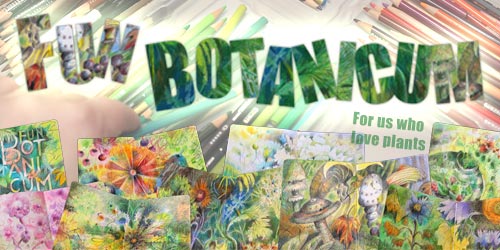
Painting a Mystery
This week is about painting a mystery and entering another world through art-making. My paintings are in an art journal and made with a loose touch.

It All Started from a Withering Bouquet
“The Midsummer bouquet has withered. I have to throw it in the trash,” I said. “But the setting is just like those old masters’ paintings,” my husband replied unexpectedly. And so I remembered this once again.

Once Upon a Time
Once upon a time, there was
and there still is a world that you can get to from anywhere.
At first, it’s dark, but you can hear a woman reading a letter to someone.

You hear a clock ticking backwards, generating more time.

Then you know that it’s time to take a brush in your hand.

Squeeze the handle firmly and hear the trees moaning as their trunks slowly sink to the ground.
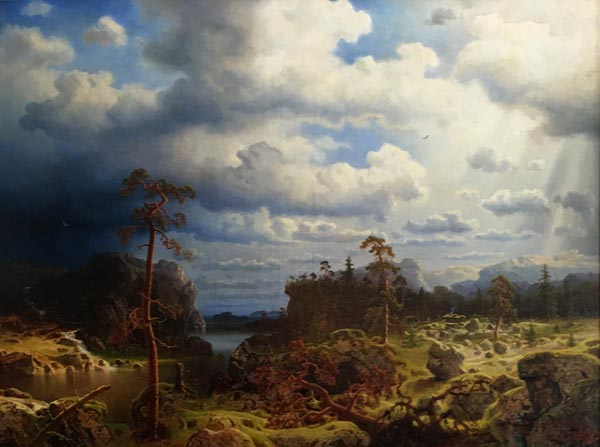
First, it feels silly to paint because there’s nothing to see.

But the darkness gradually disappears, and you realize that you are not alone.

Those strange creatures are all familiar to each other and, in a strange way, to you too.

In this world, everything has been mixed up.
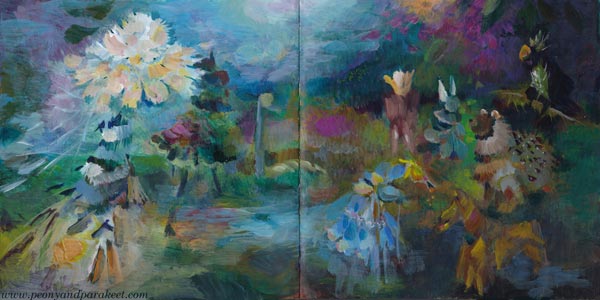
You are the wind that shook the flower, and in blowing the petals back, you lost your soul to it.

You are the chair for which the imagination built a room to rest.

In this world, everything is unfinished. But if you are willing to hear and feel instead of only seeing what’s expected, everything is ready enough.

Painting a Mystery – Background Story
The idea of this blog post came from that short conversation with my husband. Then I had to take a photo of the bouquet and make it in the style of old masters.
After that, I remembered taking a photo of a painting called “Woman Reading and a Man Seated at a Table” at the exhibition of the H’Art Museum in Amsterdam. The painting is by Frans van Mieris from 1676.
While browsing my image archive, I was drawn by another photo, taken in the same trip to Amsterdam. It was a decorative mantel clock from 1782 in the Rijksmuseum.
The clock took my thoughts to a more recent visit in Porvoo, Finland, where my husband and I went to see Johan Ludvig Runeberg‘s home. The lovely interior was from the 1860s, and there was a big painting that I really liked. I took a photo, but haven’t succeeded in finding out who painted it.
After gathering the photos, I picked up my art journal (Dylusions Creative Journal Square) and started painting. I didn’t copy the photos, but let them soak in freely. I was just inspired by the atmosphere they evoked in me.
Hopefully this blog post inspires you to paint freely without strict plans and definitions. Painting a mystery is both fun and addicting – I am already eager to create more!
Art Journal as a Storybook
This week, we are looking at an art journal as a storybook, full of fairy tales that are not borrowed but our own.
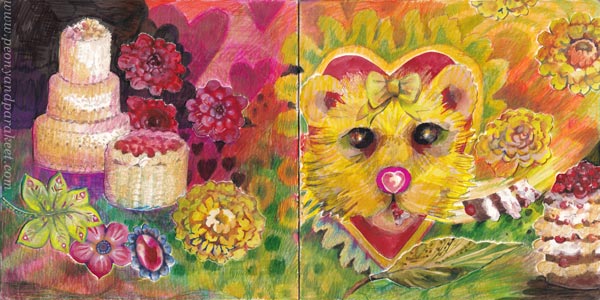
With this video, I want to inspire you to create whimsical art journal pages that illustrate personal stories. In these pages, mundane things become more fantastical, and there’s no pressure to draw realistic sceneries, real persons, and such.
I say in the video: “As a child, I drew lions without thinking if they were realistic enough. I loved lions, so I drew them, it was that simple. When I cherish the inner child, I don’t expect realistic perfection, neither do I try to control the story.”
Creating a page in your storybook journal can be a creative adventure that gets you hooked on creating.
Art Journal as a Storybook – Watch the video!
In the video, I use watercolors, colored pencils, and fel-tip pens and create a spread in my Dylusions Creative Journal. I start with creating the central heart on a separate paper ( Fabriano Accademia drawing paper, thickness 200 gsm/94 lbs), and then pick one of my boxes of joy to find more hand-drawn collage pieces.
I don’t start with the background, but glue the pieces first, and then combine them by coloring. This vice-versa collage process is fun because we can make odd images work together by drawing and also make them to tell a story.
I also like to start with a simple shape and work from a small detail to a bigger picture. I think this way of creating is exciting and adventurous, and it’s always a joy to see what comes up.
Hearts and Stories – Sign Up Now!
Let’s turn your art journal into a storybook and make the most out of simple shapes!
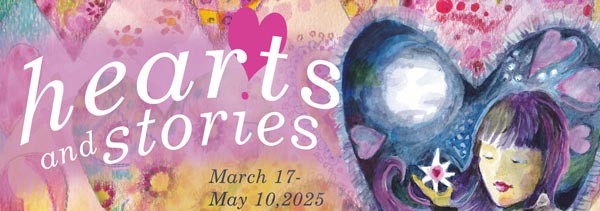
Hearts and Stories will begin on March 17, 2025. >> Sign Up Now!
Choosing the Word for 2025
Have you ever chosen the word for the new year and then happily forgotten it? Me too!
But last year, I had a word that stuck in my mind. It was “Integrate”. My word for 2025 is “Release”.
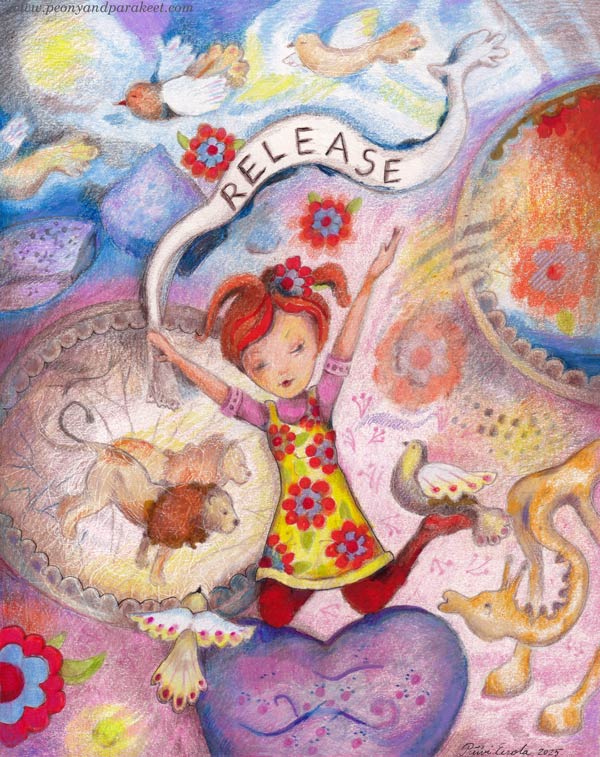
Here’s what I have learned about choosing the word!
Too Much Emotion, Too Little Impact
Some words appeal more to emotion, some to reason. Most often, I have chosen a word that has an emotional appeal. For example, “Imagination”, “Depth” or “Play“. There are plenty of these kinds of soft words, here are some common ones: “Joy”, “Courage”, “Inspire”, “Create”, “Focus”, “Nurture.”
These soft words that make your imagination run wild may seem like good choices, but they have this downside: when you’re busy working, your head is full of rational words. Emotional words don’t come to mind at that moment. This way, the practical connection to the word is missing.
My word for 2024 – “Integrate” – was a rather uninspiring word at first, but it became more and more inspiring over the course of the year. The idea was that even though I was doing a variety of art – drawing, painting and programming digital motion art – I could look for connections between different art forms so that I didn’t have to reinvent everything. I could also value more what I had created in previous years. This union of old and new worked out nicely, and with the word, I began to see my artistic career as a whole and not just an attempt to improve my artistry piece by piece.
The best thing about the word was that it didn’t describe the actual result but solved how to get there. So when I encountered problems, “Integrate” often offered at least a partial solution. That way the word came to mind repeatedly and helped me in situations when my inspiration was at its lowest.
Word That Changes Your Life
I think the best words are those that initiate change for the better. I have often chosen a word that is already familiar and doesn’t make me change anything. This year, my first candidate was “Elevate.” It sounded too soft, so I found a similar rational word “Upgrade.” But since I always try to improve my actions and the level of my art in general, I rejected “Upgrade” and chose “Release” instead.
To me, “Release” means letting go of what I’ve been holding in my heart and letting it come out. I want to give myself permission to be naive, naughty, brutal, overly cute, everything and anything, and start to blindly believe in my artistic vision. Release also means publishing what I’ve done openly and regularly and working with that in mind. Letting go and publishing is a bittersweet combination that really challenges me.
Release also means that I can let go of things if they hinder rather than help the cause.
Drawing the Word for 2025
Writing about the word is good, but I also wanted to process the word by drawing.

By drawing, you always find new dimensions. Even the hardest words become softer and create emotional connection.

One thing leads to another. I love this way of drawing where the result remains a surprise for a long time.
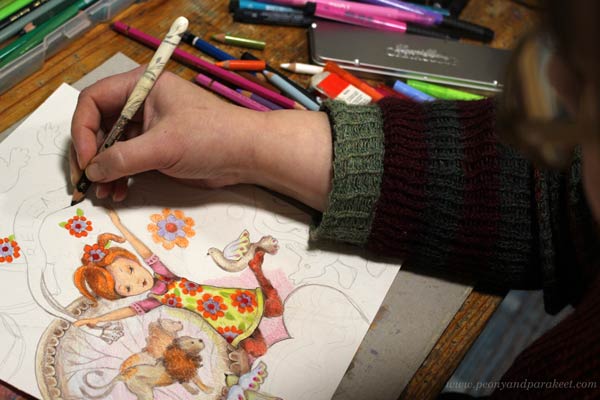
I combined colored pencils and markers here. I like the soft impression of colored pencils, but I used felt-tip pens in the highlights to intensify the colors.

When the drawing was half-finished I compared it to the little pieces I had drawn during the Christmas holiday.
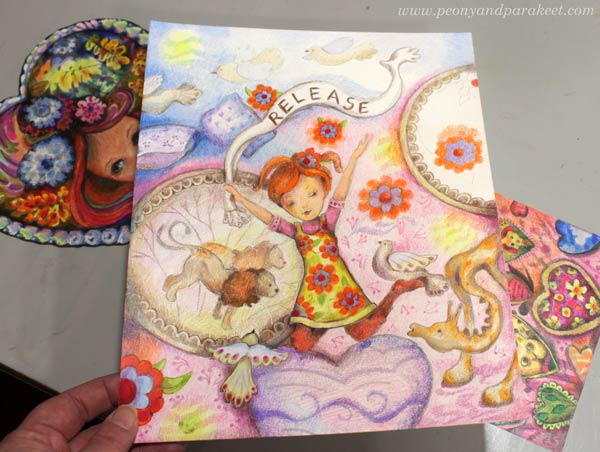
The colors still needs to be strengthened and details adjusted.
Finding the Connection with the Word
Even though this drawing isn’t very big, about letter size, there are a lot of details. I took many breaks and it took me about 3 days to finish the drawing. For the illustration that combines the right and the left brain, it’s important to find the connection between all the details and understand how they express the word.
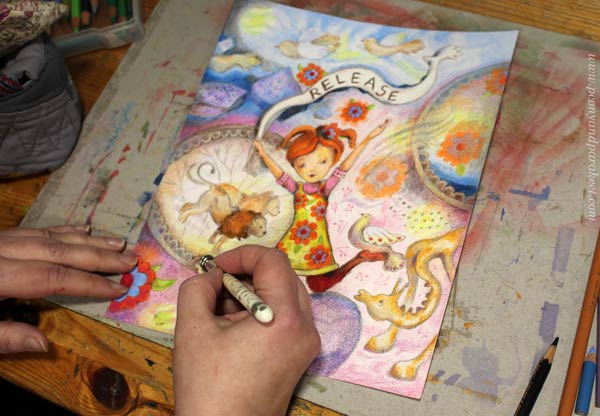
This drawing depicts my childhood in the 70s with plastic animals and daydreaming. The drawing feels revealing to me, although its style is playful.

Even if the picture feels a bit private, I want to share it with you: release, you know!

What’s your word for 2025?
Are you going to draw it?